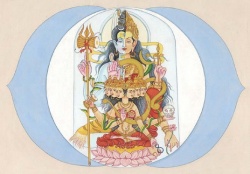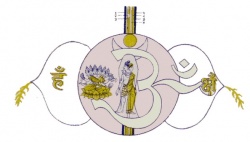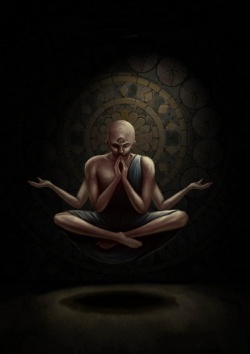Ajna
Ajna (Sanskrit: आज्ञा, ājňā, aːɟɲʌ, meaning 'command' or 'summoning') is the sixth primary chakra according to Hindu tradition.
Location
The Ajna chakra is positioned in the brain directly behind the center of the forehead, while its ksehtram, or superficial activation site, is at the eyebrow region in the position of the "third eye."
Appearance
Ajna is white in colour, with two white petals. Inside the pericarp is the Shakti Hakini, who is moon white, with six faces, and six arms, holding a book, a skull, a drum, a rosary, and making the gestures of granting boons and dispelling fears. Above her is a downward pointing triangle, within which is a moon-white lingum. In some systems the deity Ardhanarishvara a hermaphrodite form of Shiva-Shakti, symbolising the primordial duality of subject and object, resides within the lingum. Above the triangle is another smaller triangle, within which is the bija mantra Aum.
Bija or Seed mantra
The seed syllable is Aum, or "Pranava Om", the supreme sound.
Petals
Ajna has two white petals, said to represent the psychic channels, Ida and Pingala, which meet here with the central Sushumna nadi (channel) before rising to the crown chakra, Sahasrara. Written upon them in white are the letters 'Ham' on the left petal, and 'ksham' on the right petal, representing Shiva and Shakti, respectively. These petals also represent the manifest and unmanifest mind, and are said by some to represent the pineal and pituitary glands.
Function
Ajna translates as 'command', and is considered as the eye of intuition. When something is seen in the mind's eye, or in a dream, it is being 'seen' by Ajna. It is a bridge that links gurus with disciples, allowing mind communication to occur between two people. The sense organ and action organ associated with Ajna is the mind in both cases.
Hindus believe that spiritual energy from the external environments enter their body through this gateway and hence take utmost precaution in protecting it with spiritually positive protecting forces. The various religious marks one sees on the foreheads of men and women belonging to the Hindu faith (like holy ash,namam, vermilion etc.) are thus the blessed spiritual prasadam of their respective form of the Hindu gods.
Meditation upon Ajna supposedly grants the following siddhis or occult powers: to quickly enter anothers body at will; to become omniscient; he realizes unity with Brahman; and he has the ability to create, preserve and destroy the three worlds.
Manas Chakra
Directly above Ajna is a minor chakra known as Manas, or mind. It possesses six petals, one for each of the five senses, and one for sleep. These petals are normally white, but assume the colour of the senses when activated by them, and they are black during sleep. Its function is to send sense perceptions to the higher chakras.
Association with the body.
Ajna is associated with the third eye on the forehead. It is sometimes associated with the pineal gland, and sometimes with the pituitary gland. The pineal gland is actually related to a light sensitive 'third eye' (Parietal eye) found in some lizards, amphibians and fish, and regulates the circadian rhythms, while the pituitary gland is considered as the master gland of all endocrine glands, whose secretions control all the other endocrine glands.
Practices
In kundalini yoga, different practices are said to stimulate the Ajna chakra, including Trataka (steady gazing), Shambhavi Mudra (gazing at the space between the eyebrows), and some forms of Pranayama (breath exercises).
Comparisons with other systems
In Tibetan buddhism, this chakra is at the end of the central channel, which in their system runs up the body to the top of the head, and then over and down to the forehead, where it terminates. The 2 side channels then continue onwards towards the two nostrils, and end there. This centre is frequently depicted in artwork as the 'third eye,' and is used in various meditations.
There is also a forehead centre above the third eye, which corresponds to the position of Manas, known as the Wind Wheel, which is one of the ten chakras in the Mahayoga tantra traditions.
In Qigong, the highest Dantian is located in this position. This is one of three 'furnaces' that converts the different sorts of energy in the body. In this Dantian, the spiritual shen energy is converted into wuji, the infinite space of void.
Within the system of Lataif-e-sitta there exists a Lataif known as Khafi, or arcane subtlety, in this same position, and is related to mystical intuition.
In the Kabbalah, there are two sephiroth located on the sixth level, associated with the left and right parts of the face. They are called Chokmah, wisdom, and Binah, understanding, and it is at these points that the two side pillars of mercy and severity terminate, while the central pillar carries on rising to kether, the crown.
Alternative names
In Tantra: Ajita-Patra, Ajna, Ajna-Pura, Ajna-Puri, Ajnamhuja, Ajnapankaja, Bhru-Madhya, Bhru-Madhya-Chakra, Bhru-Madhyaga-Padma, Bhru-Mandala, Bhru-Mula, Bhru-Saroruha, Dwidala, Dwidala-Kamala, Dwidalambuja, Dwipatra, Jnana-Padma, Netra-Padma, Netra-Patra, Shiva-Padma, Triweni-Kamala
In the Vedas, Upanishads: Ajna, Baindawa-Sthana, Bhru Chakra, Bhruyugamadhyabila, Dwidala
In the Puranas: Ajna, Dwidala, Trirasna


